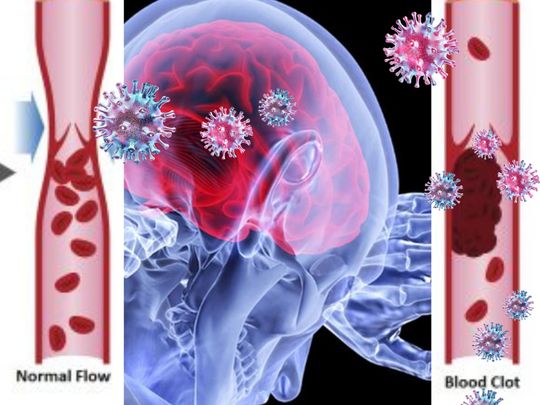
Dubai: COVID-19 has been dubbed as “atypical" pneumonia. Pneumonia is an infection in one or both lungs, usually caused by bacteria, viruses, or fungi.
But clinical researchers who treated COVID-19 patients are flustered: “Atypical" pneumonia would mean just pneumonia — with some "difference”.
But that difference is huge. Also deadly, and very much ill-defined, especially in the initial stages of the pandemic.
Clinicians have noted and encountered a high incidence of blood clotting in COVID-19 patients who develop severe illness.
Not a simple pneumonia
If COVID-19 triggers only “atypical” pneumonia, it does not fully explain the elevated levels of a protein indicating blood clotting and bleeding in patients with poor prognosis, who eventually die.
Researchers had seen one interesting evidence: traces of SARS-CoV-2 (the virus that causes COVID-19) were present in brain of rhesus macaque monkeys challenged with the virus and later autopsied in a lab, according to a pre-print version of a study published in the server BioRXiv. Pre-print means it's not been peer-reviewed yet.
Now, peer-reviewed studies done by 4 teams of clinicians who poured through files of hundreds of patients in 3 countries seem to confirm the virus' novel mechanism of virulence.
Despite the diversity and geography among patients, the researchers found one thing in common: Among patients with high COVID-19 severity, elevated levels of blood clotting, as measured by the presence of D-Dimer, were found. D-Dimer is a protein fragment that's made when a blood clot dissolves in the body.
In the four peer-reviewed research in China, the US and the UK, the most typical findings in patients with COVID-19 and coagulopathy is an increased D-Dimer concentration, in addition to a relative drop in platelet count, and a prolonged “prothrombin time” (PT).
Such tests use standardised assays (measured in terms of prothrombin ratio and international normalised ratio, INR) to evaluate the extrinsic pathway and common pathway of coagulation. This blood test is also called protime INR and PT/INR.
One study, published on May 11, 2020 in The Lancet found elevated D-Dimer levels (>0·5 mg/L) in 260 (46%) of 560 PCR test-confirmed COVID-19 patients.
What does a spike in D-Dimer concentration show?
In the second study, involving 183 patients with COVID-19, with results published in the Journal of Thrombosis and Haemostasis (JTH), researchers also found an abnormal spike in D-Dimer concentration in patients who died.
Clinicians who did the JTH study measured D-Dimer concentration of 2·12 mg/L (range 0·77–5·27) in patients who didn't survive — compared to a concentration of 0·61 mg/L (0·35–1·29) in survivors.
Their conclusion: Abnormal coagulation parameters have statistical significance associated with "poor prognosis" in COVID-19 patients, who were initially diagnosed with "novel coronavirus pneumonia".
D-Dimers are cross-linked fibrin degradation present in the blood of most healthy individuals, but in only negligible amounts (of the order 100-200 ng/mL).
As objective evidence of increased fibrinolysis, elevated blood concentration of D-Dimer is, by extension, evidence of intravascular coagulation and thrombotic disease. [Source: https://bit.ly/3fYy6ka]
18x risk of death associated with D-Dimer
The third clinical research, involving 191 patients with results published in The Lancet (March 28-April 3, 2020 edition), showed the most damning evidence of fatalitieis associated with higher D-Dimer levels.
Clinicians in Wuhan who conducted the “retrospective cohort study” on COVID-19 patients (≥18 years old) at Jinyintan Hospital and Wuhan Pulmonary Hospital (both in Wuhan, China) concluded the following: "D-Dimer on admission greater than 1 mg/L resulted in an 18x increased risk of death (95% CI 2·6–128·6; p=0·0033)".
COVID-19 and blockage of brain blood vessels
A fourth study, published by a team of neurologists from University College London (UCL) and UCLH (the National Hospital for Neurology and Neurosurgery) wrote about their clinical observations of COVID-19 patients, who went on to have a stroke.
Their main hypothesis: “Coronavirus may cause clots within blood vessels (arteries) in the brain.”
Like the findings of their Wuhan counterparts, the London doctors suggested that early testing for D-dimer, a protein fragment in the blood associated with increased blood clotting (thrombosis) in COVID-19 patients, could enable clinicians to prescribe specific treatments.

Emerging pattern
“Many patients with severe COVID-19 present with coagulation abnormalities that mimic other systemic coagulopathies associated with severe infections, such as disseminated intravascular coagulation (DIC) or thrombotic microangiopathy, but COVID-19 has distinct features,” the researchers reported.
Their conclusion: Coagulopathy (bleeding disorder) in patients with COVID-19 is associated with an increased risk of death.
Now, the relevance of COVID-19-coagulation abnormalities are becoming increasingly clear. This is because a substantial proportion of patients with severe COVID-19 develop, sometimes unrecognised, "venous and arterial thromboembolic complications," the researchers added.
Clinician’s interpretation:
One interpretation is that an elevated D-Dimer (greater than 1 μg/mL) is big risk factor for COVID-19 patients, alongside age and higher Sequential Organ Failure Assessment (SOFA) score.
This, the London researchers pointed out, could help clinicians to identify patients with poor prognosis at an early stage.
D-dimers are protein products of cross-linked fibrin degradation that are present in the blood of most healthy individuals in only negligible amounts (of the order 100-200 ng/mL). As objective evidence of increased fibrinolysis, elevated blood concentration of D-dimer is by extension evidence of intravascular coagulation and thrombotic disease. [Source: https://acutecaretesting.org/en/journal-scans/causes-of-increased-d-dimer]
What does D-Dimer test indicate?
The D-dimer test is now routinely used in the first-line assessment of patients suspected of suffering venous thromboembolism (VTE), which can present as either deep vein thrombosis (DVT) or pulmonary embolism (PE).
Both blood clotting and difficulty with clotting may occur, causing a vicious cycle.
Best course of treatment for high D-Dimer levels?
What’s the best course of treatment to deal with elevated D-Diner, when it’s a known risk factor for poor prognosis among COVID-19 patients?
By definition, in patients with thromboembolic diseases, anti-coagulation leads to lowering levels of D-dimer.
Experts, however, warn that it cannot be assumed that this intervention (use of anticoagulant) may be simply done in patients with septic disseminated intravascular coagulation (DIC).
The London team, who published their work in the Journal of Neurology, Neurosurgery, and Psychiatry, suggest to clinicians a treatment that includes anticoagulants ("blood thinners"), “at a much earlier stage, which might reduce the number of people subsequently having further strokes or blood clots elsewhere in the body.”
For example, a deep vein thrombosis (DVT, blood clot in the leg or lower extremity) can happen if you have a medical condition that keeps you immobile or if you have been sitting for a long period of time without getting up and stretching (in plane, office, car, or train). If the clot breaks off from the vein or artery of a leg it can get lodged in the blood vessels of the lung, where it can form a clot in the lung (pulmonary embolism).
This is a life threatening medical condition. Similarly, a stroke can be caused by a clot lodged in a vessel in the brain.
What’s the significance of the study?
The London team's findings, however, support other recent evidence: the exaggerated inflammatory immune response known to occur in COVID-19 patients stimulates abnormal blood coagulation, including raised D-Dimer and the production of "antiphospholipid antibodies", usually triggered by a disorder in the immune system.
Furthermore, five of the six ischemic strokes occurred 8-24 days after COVID-19 symptom onset (cough, headache, and chills), and in one patient during the pre-symptomatic phase, suggesting that COVID-19 associated ischemic stroke is usually delayed — but can occur both early and later in the course of the disease.
'Atypical' pneumonia: An incomplete diagnosis for COVID-19
To call COVID-19 effect as “atypical pneumonia”, or just a disease of the lungs, would be incomplete, given the clinical evidence that’s building up, say experts.
“Our findings suggest that blockages of large brain arteries in COVID-19 patients are associated with highly abnormal blood clotting,” explained Professor David Werring, Professor of Clinical Neurology at UCL and a Consultant Neurologist at the National Hospital for Neurology and Neurosurgery, Queen Square, London,
"Early use of anticoagulant drugs might be helpful, but this needs to be balanced against their brain bleeding risk, especially soon after an ischemic stroke.”
[Disclaimer: The London team studied only six patients, aged between 53 and 85, who had large vessel occlusion (large arterial blockage), with elevated blood levels of D-Dimer, indicating the presence of abnormally high "fibrin degradation products" — components in the blood produced when clots break down. They stated: “This report is based on a small number of patients, and doesn't confirm a direct link between COVID-19 and stroke (as other factors that are linked to stroke were present in most patients).”]








